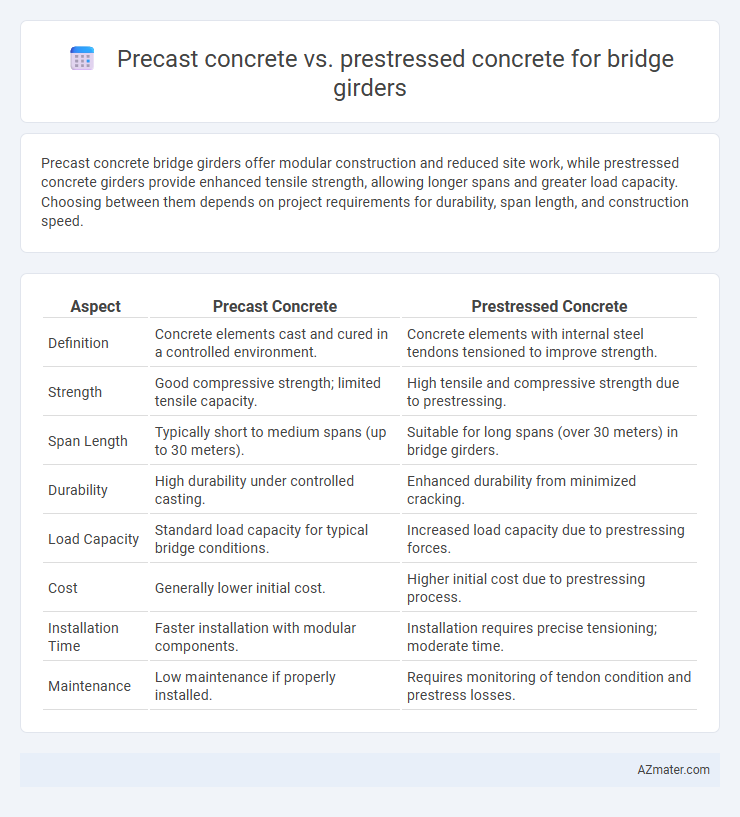Precast concrete bridge girders offer modular construction and reduced site work, while prestressed concrete girders provide enhanced tensile strength, allowing longer spans and greater load capacity. Choosing between them depends on project requirements for durability, span length, and construction speed.
Table of Comparison
| Aspect | Precast Concrete | Prestressed Concrete |
|---|---|---|
| Definition | Concrete elements cast and cured in a controlled environment. | Concrete elements with internal steel tendons tensioned to improve strength. |
| Strength | Good compressive strength; limited tensile capacity. | High tensile and compressive strength due to prestressing. |
| Span Length | Typically short to medium spans (up to 30 meters). | Suitable for long spans (over 30 meters) in bridge girders. |
| Durability | High durability under controlled casting. | Enhanced durability from minimized cracking. |
| Load Capacity | Standard load capacity for typical bridge conditions. | Increased load capacity due to prestressing forces. |
| Cost | Generally lower initial cost. | Higher initial cost due to prestressing process. |
| Installation Time | Faster installation with modular components. | Installation requires precise tensioning; moderate time. |
| Maintenance | Low maintenance if properly installed. | Requires monitoring of tendon condition and prestress losses. |
Introduction to Bridge Girders
Bridge girders serve as primary structural elements supporting loads from the deck to the piers or abutments, with precast concrete girders manufactured off-site and installed rapidly, offering consistent quality and reduced construction time. Prestressed concrete girders incorporate tensioned steel tendons, enhancing tensile strength and allowing longer spans with thinner sections, improving load capacity and durability. Choosing between precast and prestressed concrete girders depends on project requirements such as span length, load demands, and construction schedule.
Understanding Precast Concrete
Precast concrete for bridge girders involves casting concrete components in a controlled factory environment, ensuring consistent quality and precise dimensions. This method allows for rapid on-site assembly, reducing construction time and minimizing traffic disruptions. Precast girders are typically reinforced with steel bars to handle tensile stresses, offering durability and ease of installation compared to cast-in-place alternatives.
Defining Prestressed Concrete
Prestressed concrete for bridge girders involves introducing internal stresses prior to loading to counteract tensile forces, enhancing load-carrying capacity and reducing material usage. Unlike precast concrete, which is simply cast and cured off-site before placement, prestressed concrete uses tensioned steel tendons embedded within the concrete to achieve superior strength and durability. This technique allows for longer spans and slimmer girder profiles, making it ideal for modern bridge engineering.
Key Differences Between Precast and Prestressed Concrete
Precast concrete bridge girders are manufactured off-site and rely on their mass and reinforcement for strength, while prestressed concrete girders incorporate tensioned steel tendons to counteract tensile stresses, enhancing load capacity and reducing deflection. Prestressed concrete offers superior performance for longer spans and heavier loads due to its improved tensile strength and crack resistance. In contrast, precast concrete is often more economical and easier to produce for shorter spans with moderate loading requirements.
Structural Performance Comparison
Precast concrete bridge girders offer high compressive strength and excellent durability, making them suitable for moderate span lengths and standard load conditions. Prestressed concrete girders enhance structural performance by introducing controlled tensile stresses, allowing for longer spans, reduced girder depth, and improved resistance to cracking and deflection under heavy loads. The prestressing process significantly increases load-carrying capacity and service life, making prestressed concrete girders more efficient for bridges requiring higher structural demands.
Cost Implications for Bridge Construction
Precast concrete bridge girders typically offer lower initial costs due to standardized factory production and reduced on-site labor, whereas prestressed concrete girders involve higher fabrication expenses driven by the use of tensioned steel strands. Cost efficiency in prestressed concrete arises from longer spans and slimmer profiles, reducing material quantities and foundation requirements, which can lower overall bridge construction expenditures. Choosing between precast and prestressed concrete girders depends on project-specific factors such as span length, load demands, and site conditions that influence total lifecycle costs and budget allocations.
Installation and Construction Speed
Precast concrete bridge girders allow for rapid on-site installation due to their factory-controlled fabrication and precise dimensions, significantly reducing construction time. Prestressed concrete girders, offering higher strength and longer spans, enable fewer supports and longer segments, which can streamline erection but may require more complex handling equipment. The combination of precasting and prestressing techniques optimizes construction speed by balancing manufacturing efficiency with structural performance on bridge projects.
Durability and Maintenance Considerations
Precast concrete bridge girders offer high durability due to factory-controlled conditions reducing voids and cracks, which minimizes long-term maintenance needs. Prestressed concrete girders provide enhanced resistance to tensile stresses and cracking, resulting in superior durability under heavy loads and environmental exposure. Maintenance for prestressed girders is often lower since the internal prestressing strands prevent common damage mechanisms such as corrosion and spalling.
Suitability for Various Bridge Types
Precast concrete girders offer exceptional versatility, making them suitable for short to medium-span bridges such as pedestrian bridges, highway overpasses, and small river crossings, due to their ease of manufacturing and rapid installation. Prestressed concrete girders are preferred for longer-span bridges like viaducts and major highway bridges, as their enhanced tensile strength allows them to handle greater loads and spans without excessive deflection. The choice between precast and prestressed concrete depends on factors like span length, load requirements, and construction speed, with prestressed options favored for high-load, long-span structures.
Choosing the Right Concrete Method for Bridge Girders
Precast concrete offers modularity and ease of installation for bridge girders, making it suitable for projects with tight timelines and standardized designs. Prestressed concrete girders provide superior load-carrying capacity and reduced structural depth, ideal for longer spans and high-stress conditions. Selecting between precast and prestressed concrete depends on factors such as span length, load requirements, site conditions, and project budget to ensure optimal durability and performance.

Infographic: Precast concrete vs Prestressed concrete for Bridge girder
 azmater.com
azmater.com